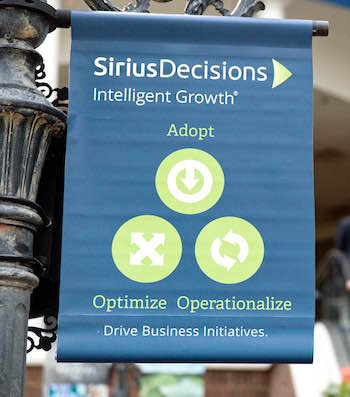A Little More About Digital Type (Summit SiriusLab Part 2)
- The SiriusDecisions Digital Type Assessment Tool is useful for identifying digital marketing characteristics and requirements for your business or a specific business initiative
- Digital type is situational, so be aware that you can have more than one digital type at the same time
- Determining digital type is only the first step in a transformational process to optimize your marketing tactics and investments aligned to your buyers’ journey
At SiriusDecisions’ annual Summit in Nashville last month, my colleague Chris Parr and I presented a SiriusLab called “Digital Typing in B2B.” SiriusLabs is a new presentation format through which we demonstrate SiriusToolsTM that help marketing, sales and product professionals operationalize SiriusDecisions models and frameworks. Our lab featured the Digital Type Assessment Tool.

The Digital Type Assessment Tool aligns with some of our recent research on the subject of digital marketing, including the Core Strategy Report “Building the Digital Organization” and the Role Profile “Digital Strategist.” The tool helps organizations identify their “digital type” – Digital First, Digital Support or any of three digital hybrids – as described in detail in the Core Strategy Report. Digital type is a function of three simple inputs: your offering, your purchase complexity and your go-to-market approach. There are six input parameters, scored on a scale of 1 to 5, that cross these three dimensions. These six parameters fully describe the digital types, and your organization’s total score across them indicates which type your organization has. Because the digital type concepts are straightforward and the inputs should be readily accessible to any seasoned marketer, the digital type score is very easy to calculate.
So once you know your digital type, what should you do with that information? How can that revelation have a positive impact on your marketing, sales and product efforts?
While most SiriusTools are fairly tactical, providing output that may be put to use immediately (e.g. budget allocation, lead source mix), the Digital Type Assessment Tool is much more strategic – creating a whole new set of considerations for the marketing team. So as a followup to our SiriusLab, I want to tie the Digital Type Assessment Tool back to our research to provide more detailed next steps for the digital marketer and the marketing strategist.
After determining its digital type, the organization should take stock of its strengths and weaknesses and build out all necessary capability areas to align with this type. There are three broad considerations:
- Organization and skills. These are the roles and capabilities required for the marketing, sales and product functions. For example, in a Digital First organization, the sales function tends to support e-commerce-enabled transactions with customer support representatives and chat agents. In a Digital Support organization, however, the sales function leads, often with complex field sales teams that are regional, account-based or both. Similarly, the marketing function will be highly invested in digital marketing and store operations in the Digital First type, but will play more of a supporting role in the Digital Support type, focusing a significant amount of time on sales support and enablement, lead nurturing and deal acceleration.
- Process and measurement. At both ends of the spectrum, from Digital First to Digital Support, you will be able to examine and analyze views of the SiriusDecisions Demand Waterfall®. In a Digital First organization, almost all of the focus will be at the top of the Demand Waterfall. Measurement likely will include comparative results for various digital marketing efforts that drive inbound response, Web site activity, content downloads, trials and e-commerce purchases, with an emphasis on conversion rates for each stage of the journey. There may or may not be teleprospecting generated leads (TGLs) – in fact, it’s possible that the lower Demand Waterfall (sales stage) won’t exist at all.
In a Digital Support organization, there likely will be a more balanced Demand Waterfall, with activities driven by marketing (inquiry to automation qualified leads), teleprospecting qualification (teleprospecting accepted leads to teleprospecting qualified leads, and perhaps teleprospecting efforts to create TGLs), and sales (sales accepted leads to closed/won opportunities, and perhaps sales prospecting to create sales generated leads). Measurement will look at each stage, and optimization will consider conversion rates across stages (see “The SiriusDecisions Demand Waterfall® Pattern Tool”).
- Technology. A Digital First organization invests more heavily in technology related to Web content management, content targeting, e-commerce stores and technology-facilitated trials, and uses analytics tools that focus on measurement and optimizing conversion. A Digital Support organization focuses on technologies that enable sales and track and analyze sales opportunities for sales management reporting. Both digital types benefit from technologies that support lead nurturing – nurturing for Digital First organizations is biased toward digital touches, while Digital Support organizations tend to blend digital and human touches.
Now, here is another twist. Digital type may be situational, so you might have more than one digital type at any given time. Here’s the example we modeled in our SiriusLab: Your traditional business might be led by a strong direct selling effort and score as Digital Support, but then you might have a new initiative to offer a simple, lower-cost variation of your product using e-commerce, which looks more like Digital First. So now you’ll need a mix of skills, processes, measures and technology to simultaneously optimize both sides of the business.
Determining your digital type using our tool is easy, but the process of transforming your organization to be aligned optimally with your digital type? Not so much. SiriusConsultingTM is here to help with deep assessment capabilities to diagnose what you need to do; models and frameworks to optimize your skills, processes, metrics and technology choices; and digital transformation workshops to get all of your functions on board. Contact us if you need help taking that next big step.